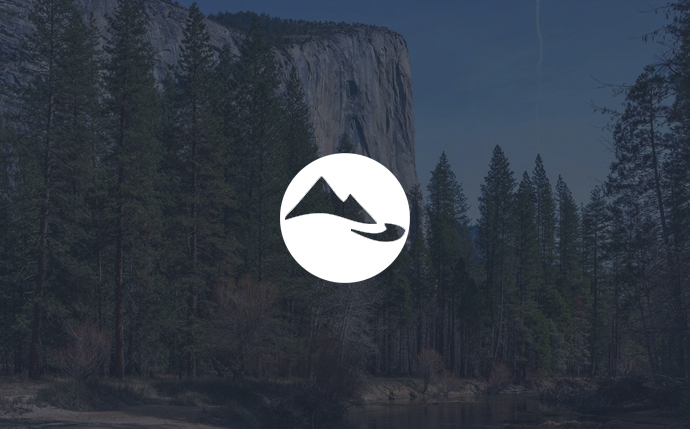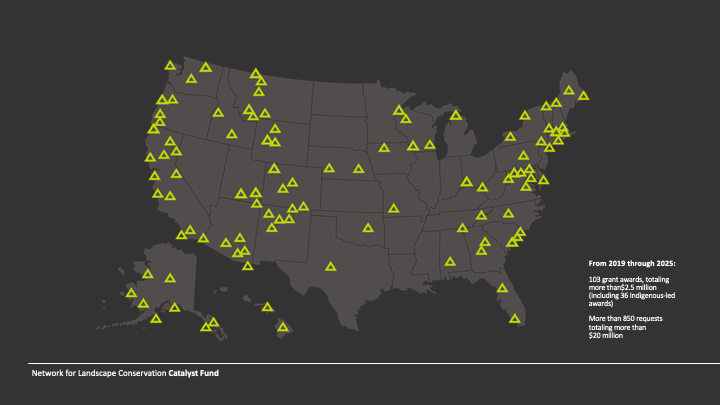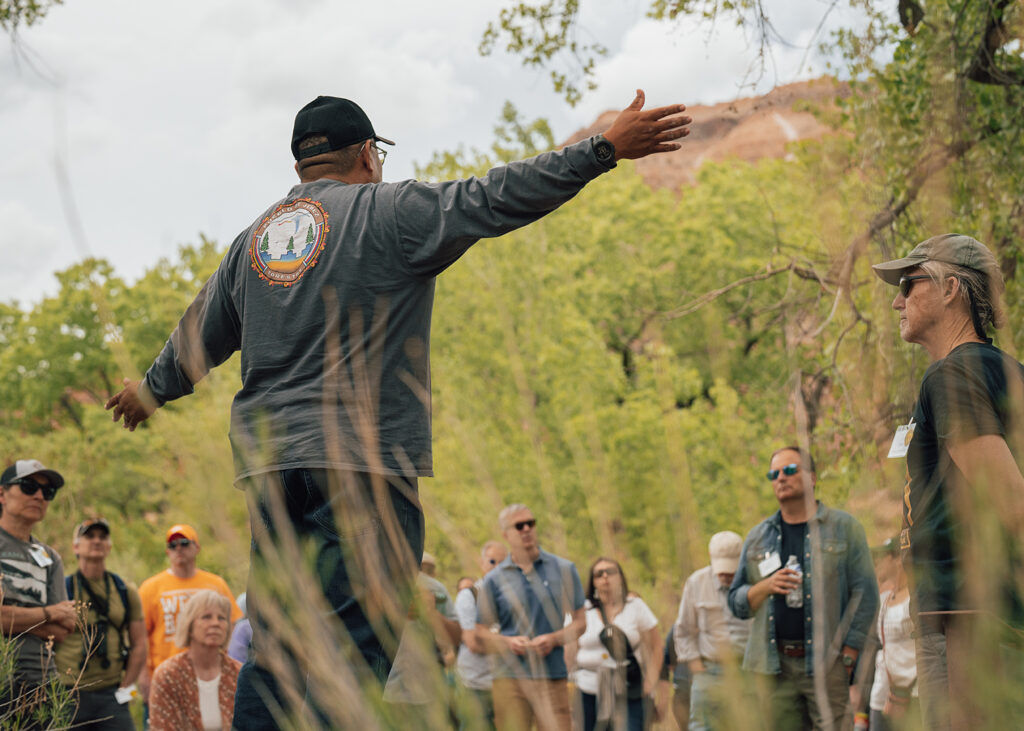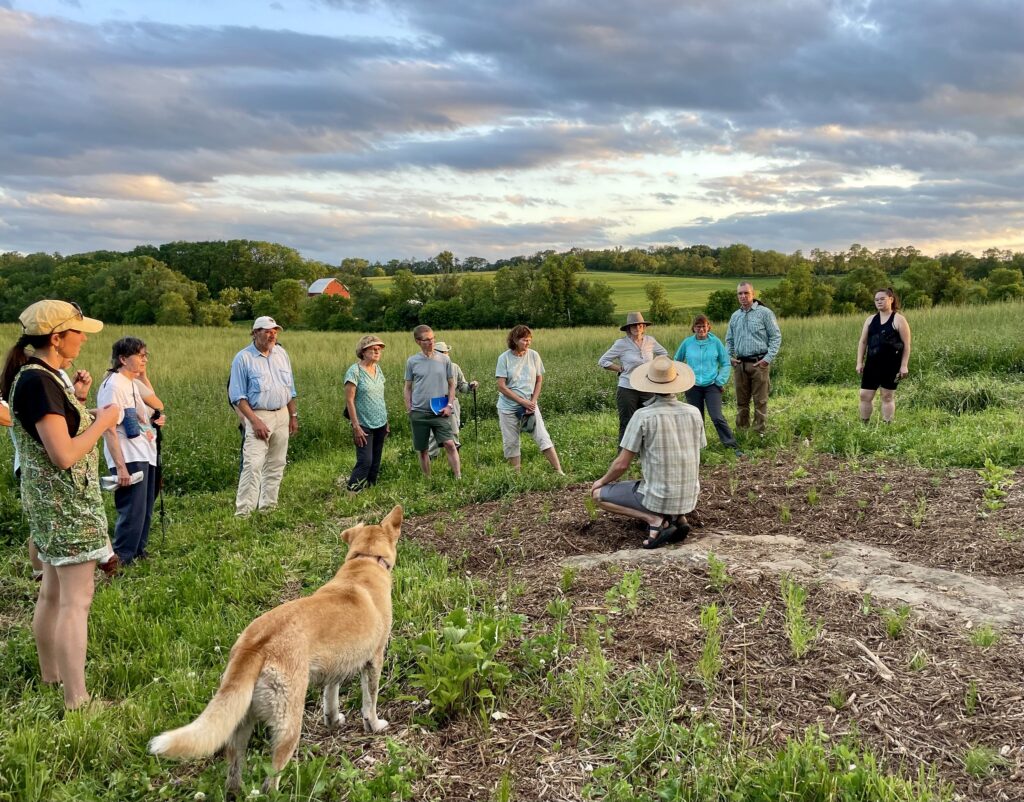
The Catalyst Fund Shows a Way to the Successful Conservation & Stewardship of America’s Landscapes
Bob Bendick, member of the Network for Landscape Conservation Coordinating CommitteeThis month, the Network for Landscape Conservation (NLC) wrapped up the 2025 grant cycle of its Catalyst Fund with the announcement of grant awards to 18 place-based, community-grounded Landscape Partnerships across the U.S. These Partnerships are bringing together diverse interests within landscapes allowing partners and communities to join together to conserve and steward the environmental, economic, and cultural benefits of their areas.

Since the Catalyst Fund launched in 2019, it has provided grant awards to 103 Landscape Partnerships–including 36 Indigenous-led Partnerships–totaling more than $2.5 million in collaborative capacity funding.
Across the last seven years of grantmaking, the Catalyst Fund has now awarded grants to 103 Landscape Partnerships—including 36 Indigenous-led Partnerships. These grants have totaled more than $2.5 million in investments in strengthening collaborative process and coordination capacity necessary for achieving important and lasting conservation, stewardship and restoration results for exceptional areas of land and water and for the diverse communities that occupy these places. I have had the opportunity to participate in the grant cycle process in each of those seven years, and I am struck by the diversity of Landscape Partnerships that we have funded and by the essential work those Partnerships are doing at this pivotal time in American conservation history.
A Brief history of the Catalyst Grant Program
The Network for Landscape Conservation launched the Catalyst Fund Program in 2019, with support from the Doris Duke Foundation and William and Flora Hewlett Foundation. The program was in response to the need expressed at group and individual meetings and by surveys across the country that there were hundreds of places in the U.S. where farmers and ranchers, non-profit organizations, government agencies, Tribal leaders, local businesses and interested citizens had joined together to shape the future of their cherished home places, but that planning, process, and staffing obstacles stood in the way of moving forward toward on-the-ground, tangible conservation and stewardship results. The Catalyst Fund Program was designed to provide a small injection of funds to overcome those obstacles, and to bring grantees together in peer learning cohorts to enable the sharing of learnings, insights, and solutions across geographies. An emphasis of the Program has been on supporting Indigenous and Tribal leadership in stewarding ancestral lands.
The response from across the country has been overwhelming. While we have had the privilege of provide grant funds to the 103 Landscape Partnerships over the life of the Catalyst Fund to date, we have received more than 850 proposals requesting support. These proposals have come from all corners of the country, from coastal Alaska to southern rivers and from the Maine woods to the Great Plains, and beyond, and from both rural and urban areas.
Seeing the Multiple Benefits of Collaborative Landscape Conservation & Stewardship
I have been struck over the last seven years by how the Catalyst Fund proposals have demonstrated that collaborative landscape conservation and stewardship has multiple benefits. In the proposals that I’ve been so fortunate to review over the years, I have seen how it:
-

Staff from the Natural Resources Department at the Pueblo of Jemez host Catalyst Fund grantees and Network for Landscape Conservation leadership for a tour in May 2023, highlighting the work of the Tri-Pueblo Coalition, a 2022 Catalyst Fund grantee. Photo courtesy of Trees, Water & People.
Brings people representing different interests together to find common ground and agree upon a direction for the future of the exceptional landscapes where they live, work and recreate. Having such an agreed-upon direction enables on-the-ground conservation action in our otherwise contentious world.
- Reconciles economic, cultural, and environmental objectives for communities and the landscapes where they are located.
- Assists Tribal governments and Indigenous communities in exercising sovereignty and in participating in (and leading) landscape planning and stewardship across ancestral lands.
- Integrates the use of scientific, local, and traditional knowledges in making decisions about the future of landscapes.
- Recognizes the knowledge and role of people engaged in natural resource industries—farmers, ranchers, foresters and fishermen.
- Creates effective mechanisms for public and private fundraising for projects to enhance landscapes by reducing conflicts and accelerating review processes.
- In urban areas, connects city dwellers to often-neglected natural features to avoid impacts from natural hazards and enhance everyday life.
- Creates the landscape building blocks for larger wildlife corridors such as those advocated by state fish and wildlife agencies.
- Provides venues for government officials to better understand and respond to citizen concerns.
- Helps to ensure the long-term continuity of conservation initiatives by creating local agreement on conservation goals and strategies.
The 18 Landscape Partnerships that are receiving grant awards this year exemplify and bring these benefits to life. In particular, to highlight three examples:
The Bronx Climate Justice Task Force: The Bronx River is New York City’s only freshwater river, flowing 23 miles south through the Borough of the Bronx, from the Kensico Reservoir in southern Westchester County to the East River, the saltwater tidal estuary that links the Upper New York Bay and the Long Island Sound. This landscape contains some of the most densely populated and environmentally burdened neighborhoods in the country—the Borough’s 1.4 million residents are 90% people of color and face high rates of poverty, asthma, and climate vulnerability. But this landscape also includes forests, wetlands, parks, rain gardens, waterways and shorelines. The river and its watershed link ecosystems and communities throughout the Bronx, providing vital ecological services. The Bronx Climate Justice Task Force, formed in 2023, builds on a deep legacy of community stewardship within the Bronx and aims to transform a fragmented, top-down planning and implementation environment into a unified, community-authored vision for resilience and conservation. The Catalyst Fund support will bolster the Task Force as it works to advance landscape-scale resilience by restoring degraded habitats, protecting biodiversity, expanding access to open space, and reducing climate-related health risks.
Curry County Landscape Partnership: The southern coast of Oregon is an array of coastal forests, upland meadows, rivers, wetlands, and estuaries that provide vital habitats for all life. With a backdrop of towering redwoods and expansive river systems, this land holds significant cultural value and deep ancestral ties for the Tututni and Chetco peoples. The region’s rich biodiversity faces increasing pressure from wildfires, sea-level rise, development, and invasive species. Although there are no federally recognized Tribes in the geography, a coalition of Native peoples has convened the Curry County Landscape Partnership. The Catalyst Fund grant will advance the Partnership’s efforts to bring together local Tribes, conservation organizations, government agencies, and community members to foster long-term conservation and climate resilience for this landscape—while ensuring the involvement of local communities, especially Native peoples, in land management decisions.
Snake River Plains Coalition: The Snake River Plain is a geologic feature that cuts across southern Idaho, carrying the Snake River on its journey west. This six-million-acre landscape is a complex patchwork of ownership, with a mix of private, state, and federal lands. The volcanic soils and access to water contribute to a productive ranching economy. While a significant portion of the landscape is managed by the Bureau of Land Management, some 180,000 acres are privately owned as working farms and ranches. This unique landscape is increasingly at risk from skyrocketing land valuations and increasing development pressures that threaten its ecological and agricultural significance. The Catalyst Fund grant will enable the Snake River Plains Coalition to build upon its efforts to bring together cross-industry collaborators—including ranchers, conservationists, researchers, and public agencies—to envision a future for the Snake River Plain landscape where working lands, vibrant communities, and wildlife habitat can coexist harmoniously.
Overall Reflections and Looking Ahead

Partners within the Driftless Area Conservation Partnership, a 2023 Catalyst Fund grantee, convene for a tour of the Sugar Valley Farm in June 2024 to learn more about biodiverse nature-based farming practices. Photo by Brenna Holzhauer, Natural Resources Foundation of Wisconsin.
As I’ve engaged in the Catalyst Fund Program over the last seven years, my experiences of learning about a remarkable diversity of landscape efforts across the country has only affirmed my belief in the importance of landscape scale thinking and long-term collaborative processes for achieving durable conservation and stewardship results. What I have seen in the Catalyst Fund has also underscored for me the value of external funding in enabling the collaborative process and coordination capacity that allow diverse partners to work together to achieve those results. A soon to be released external impact evaluation of the Catalyst Fund Program confirms this belief, as the preliminary findings have underscored that these grant awards have generated a range of positive impacts for the funded Landscape Partnerships and have accelerated on-the-ground conservation and stewardship outcomes.
My conservation career spans more than 50 years, and I have seen much in this time. In today’s America it is clear that there are multiple daunting challenges to our lands and waters that also affect the health and way of life of human communities. Among these are:
- A changing climate;
- The loss of contiguous functional habitat for plants and animals;
- The ongoing need for sustainable food and fiber production;
- A distrust of centralized governance and information sources;
- A severely divided society including insufficient opportunities for Tribal and other marginalized communities to participate or lead planning for the future.
While it would be overstating the case to claim that collaborative landscape conservation and stewardship is sufficient to address all of these challenges, what I have seen in the Catalyst Fund convinces me that it can play an important role in finding common ground among diverse interests to chart and act to achieve a good and sustainable future in landscapes across the country. These landscapes can then be the building blocks for a framework of greenspace and working lands around which Americans can build healthy and productive lives in cities and in rural areas.
The Catalyst Fund has demonstrated that, to enable this future, funding is needed to sustain collaborative processes at the landscape scale. There are some examples of existing Federal Programs like Sentinel Landscapes (Departments of Defense, Agriculture and Interior) and Partners for Fish and Wildlife (Department of the Interior), where funding supports collaborative landscape conservation and stewardship. I have seen through the Catalyst Fund, and especially with the overwhelming number of proposals we’ve received over the last seven years, that these existing Federal programs—and other private funding sources—are not able to respond to the widespread from-the-bottom-up need that exists for this type of support. The Catalyst Fund is an experiment for how investments in the collaborative process can be made, and it is clear that this approach provides a high return on those investments. In this time of uncertainty, it is important for additional funders to invest in this proven pathway to large scale conservation and stewardship of America’s natural resources.
